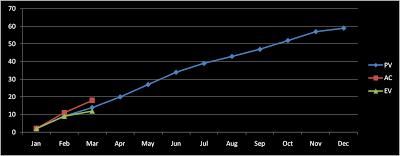The Actual Cost (AC) is a function of the time and it is a measured of how much money has been spent in a project. It's measured in units of economic value ($). Mathematically, the domain of the Actual Cost (AC) is time and the range is economic value ($). The Actual Cost (AC) is clearly associated with the Earned Value (EV) because the units of work that are measured by AC, are the same that EV has added as progress. In other words, when a unit of work has been done, EV adds the planned value of cost for that unit of work and AC adds the real cost for that unit of work.
In the following table could see an example. Let the red squares be the actual cost of each work unit. Suppose that we finished the first task, we are progressing in the second and the third hasn't been started. The real cost exceeds the budget. The actual cost is composed of the completed work, valuated at real cost.

It's a convention that the Actual Cost (AC) starts at the time zero and goes until the real duration of the project. The minimun value is zero and there is no maximun value of the Actual Cost (AC). It's possible to see the last example drawn in the following curves.

AC is also called Actual Cost of Work Performed (ACWP) and in spanish Costo Real del Trabajo Realizado (CRTR).
